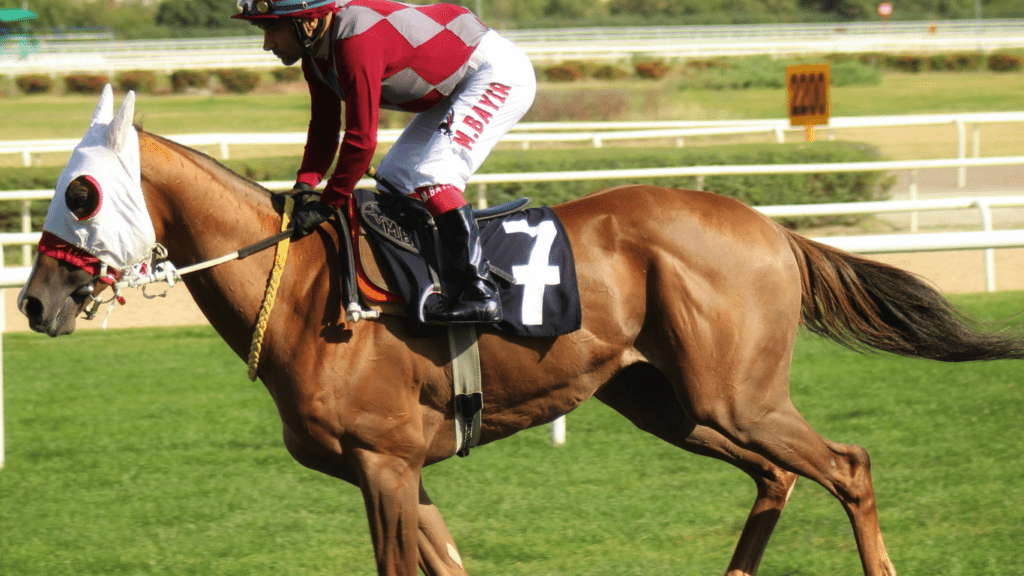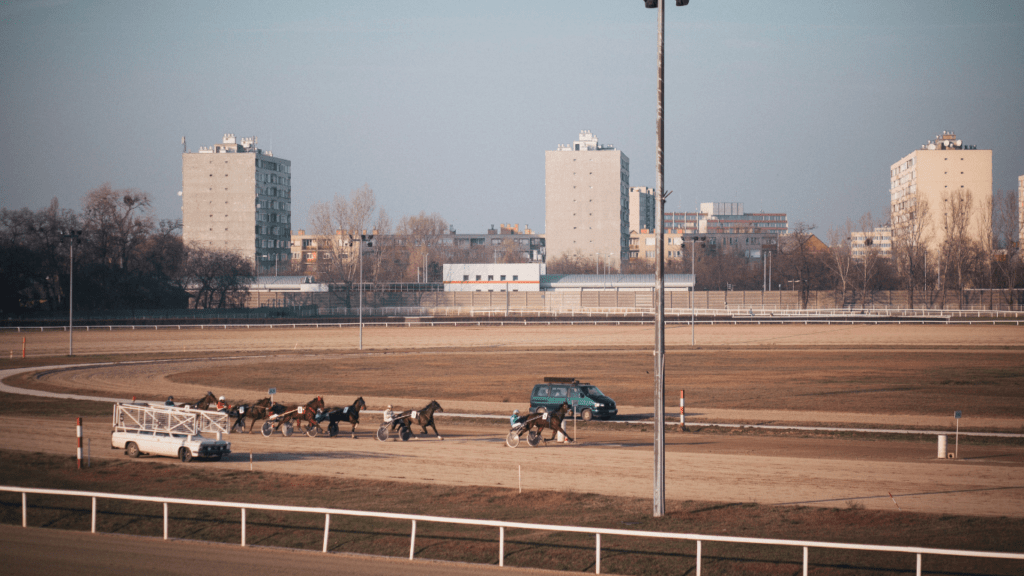The Basics Of Horse Racing Terminology
Understanding the key terms in horse racing helps engage more with the sport. Here’s a breakdown of essential concepts.
Common Terms Every Beginner Should Know
- Furlong: A furlong equals one-eighth of a mile. Most races are measured in furlongs.
- Handicap: In handicap races, horses carry different weights to level the playing field. The aim is to give each horse an equal chance of winning through weight adjustments.
- Maiden: A horse that hasn’t won a race is called a maiden. Maiden races are exclusively for such horses.
- Paddock: The paddock is the area where horses are saddled and paraded before a race. It allows owners, trainers, and spectators to assess the horses’ condition.
- Post Position: The post position is the starting gate number assigned to a horse. It’s determined by a random draw and can impact a horse’s race strategy.
Understanding Race Types And Distances
- Flat Racing: Horses race on a flat surface without obstacles. Races can vary in distance, usually between 5 furlongs and 2 miles.
- Jump Racing: Also known as steeplechasing, in jump racing, horses jump over obstacles like fences or ditches. Races range from 2 miles to over 4 miles.
- Allowance Race: These races set conditions based on age, sex, and past performance, affecting the weight horses carry.
- Claiming Race: Horses in claiming races can be purchased for a predetermined price. It’s a way for owners to buy and sell racehorses.
- Stakes Race: The highest level of competition involves stakes races, featuring the best horses with significant prize money. Owners pay entry fees contributing to the prize pool.
Key Participants In Horse Racing

Horse racing involves various key participants, each playing a crucial role in the outcome of the race and the performance of the horses.
Jockeys And Their Roles
Jockeys ride the horses during races. They maintain balance, use whips strategically, and make split-second decisions to navigate their horses through crowded fields. Jockeys also form an understanding of each horse’s strengths and weaknesses to maximize performance. Successful jockeys often have rigorous training and significant experience.
Trainers And Their Importance
Trainers prepare horses for races. They design training regimes, manage dietary plans, and handle day-to-day care. Trainers identify a horse’s potential racing strategy and work closely with jockeys to communicate these plans. A good trainer can significantly impact a horse’s career by enhancing its physical and mental readiness for races.
Owners And Their Influence
Owners finance the horses and cover expenses like training, boarding, and veterinary care. They make decisions on breeding, selling, and training methods. Owners often hire trainers and select races for their horses to compete in. Their investment and decisions directly influence the success and longevity of a horse’s racing career.
Types Of Races And Their Terminology
Horse racing features various types of races, each with specific characteristics and jargon.
Thoroughbred Racing
Thoroughbred racing, often called flat racing, involves horses running on a plain track without obstacles. Horses sprint over distances ranging from 5 furlongs to 2 miles. Major types of thoroughbred races include allowance races, handicaps, and stakes races. Allowance races let horses compete under specific conditions set by racing authorities. Handicaps involve weight adjustments to level the playing field. Stakes races represent the highest level, offer substantial prize money, and often feature the best horses.
Steeplechase Racing
Steeplechase racing, also known as jump racing, requires horses to navigate obstacles, such as fences and ditches, over longer distances. These races test a horse’s stamina and jumping ability. Common terms include hurdles and fences. Hurdles are smaller jumps while fences are larger, more challenging obstacles. Notable steeplechase races include the Grand National and the Cheltenham Gold Cup in the UK.
Harness Racing
Harness racing features horses pulling a two-wheeled cart, called a sulky, driven by a jockey. The horse’s gait is crucial, with two main forms: trotting and pacing. Trotters move their legs in diagonal pairs (left front/right rear, right front/left rear), while pacers move their legs laterally (left front/left rear, right front/right rear). Harness races typically range from 1 to 1.5 miles. Key terms include driver (the person steering the horse) and break (when a horse moves out of its designated gait, often leading to disqualification).
Betting Terms And Jargon
Betting on horse racing can be as thrilling as the race itself. Understanding the terms used in wagering helps you make informed decisions and enhances your overall experience.
Types Of Bets
Horse racing offers various types of bets, each with its unique terminology:
- Win: A bet on a horse to finish first.
- Place: A bet on a horse to finish first or second.
- Show: A bet on a horse to finish first, second, or third.
- Exacta: A bet on two horses to finish first and second in the exact order.
- Quinella: A bet on two horses to finish first and second in any order.
- Trifecta: A bet on three horses to finish first, second, and third in the exact order.
- Superfecta: A bet on four horses to finish first, second, third, and fourth in the exact order.
- Daily Double: A bet picking the winners of two consecutive races.
- Pick 3/4/5/6: A bet selecting the winners of multiple consecutive races, such as the next three, four, five, or six races.
Common Betting Slang
Racing enthusiasts often use slang to discuss bets. Here are some common terms you’ll encounter:
- Across the Board: Betting a horse to win, place, and show. If the horse wins, you collect all three payoffs.
- Chalk: The favorite or the horse with the lowest odds.
- Dead Heat: When two or more horses finish in a tie.
- Lock: A term referring to a horse considered a sure winner.
- Longshot: A horse with high odds, suggesting a low chance of winning.
- Overlay: A horse whose odds are greater than its actual chance of winning.
- Underlay: A horse whose odds are less than its actual chance of winning.
Understanding Odds
Odds represent the probability of a horse winning and determine the payout for bets. Here are key points to grasp:
- Fractional Odds: Shown as fractions, like 5/2. For every $2 bet, you’ll win $5 plus your original $2.
- Decimal Odds: Displayed as decimals, like 3.50. This means for every $1 bet, you’ll receive $3.50 if the horse wins.
- Morning Line: Initial odds set by the track’s handicapper before betting begins.
These odds continuously adjust based on the amount of money wagered on each horse.
Horse Racing Tracks And Their Terms
Horse racing tracks possess unique features that influence race outcomes. Understanding track configurations, surface types, and race programs is essential for following the sport.
Track Configurations
Tracks often vary in shape and length, which impacts how horses perform. Most tracks are oval-shaped but can range from as short as 4 furlongs to as long as 2 miles. In the US, the standard track length is 1 mile. Tracks typically have either left-handed or right-handed turns, depending on their design.
Surface Types And Their Impact
Different types of surfaces can significantly affect race results. Common track surfaces include dirt, turf, and synthetic materials.
- Dirt Tracks: These are the most common in the US. Dirt tracks can be fast or muddy, depending on weather conditions.
- Turf Tracks: Made of grass, turf tracks often produce faster times but can become slippery when wet.
- Synthetic Tracks: Designed to mimic both dirt and turf, synthetic surfaces aim to reduce injuries. They’re less affected by weather.
Understanding Race Programs
Race programs provide essential information about each race. They list entries, past performances, jockeys, trainers, and other key details.
- Entries: Names and numbers of horses entered in a race.
- Past Performances: Historical data on how horses have performed in previous races.
- Jockeys and Trainers: Identifying which jockey will ride each horse and who trained them.
- Odds: Initial and current odds for each horse, indicating their chances of winning.
Understanding these aspects of tracks enhances one’s ability to follow horse racing more effectively.


 Michaello Thomasters, the visionary founder of Bet Roll Gamble, has built a dynamic platform that serves as a hub for betting enthusiasts across various arenas, including sports, poker, horse racing, and esports. With a passion for providing valuable insights and strategies, Thomasters aimed to create a space where both novice and experienced bettors can enhance their skills and stay ahead of trends.
Michaello Thomasters, the visionary founder of Bet Roll Gamble, has built a dynamic platform that serves as a hub for betting enthusiasts across various arenas, including sports, poker, horse racing, and esports. With a passion for providing valuable insights and strategies, Thomasters aimed to create a space where both novice and experienced bettors can enhance their skills and stay ahead of trends.